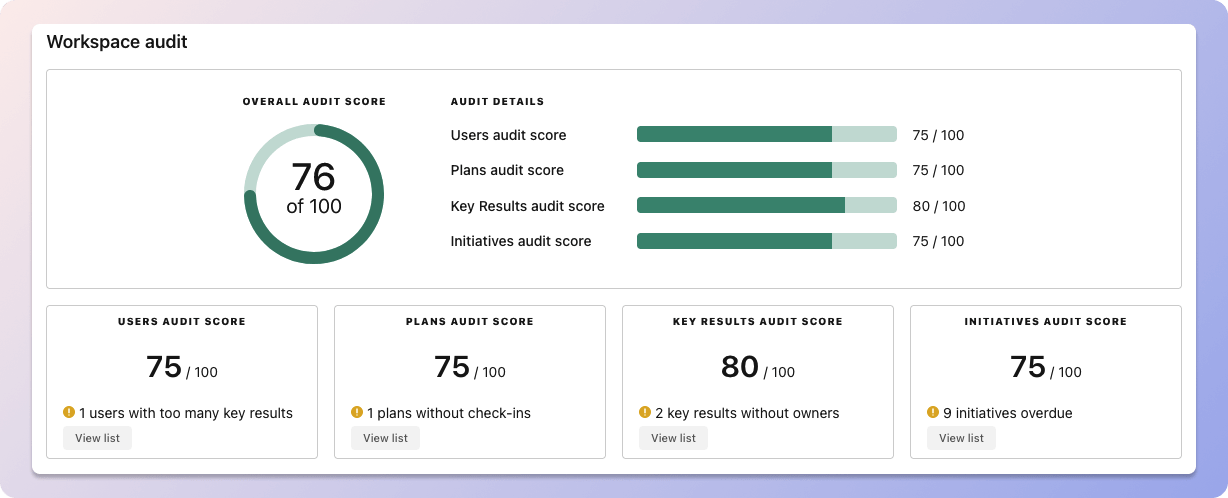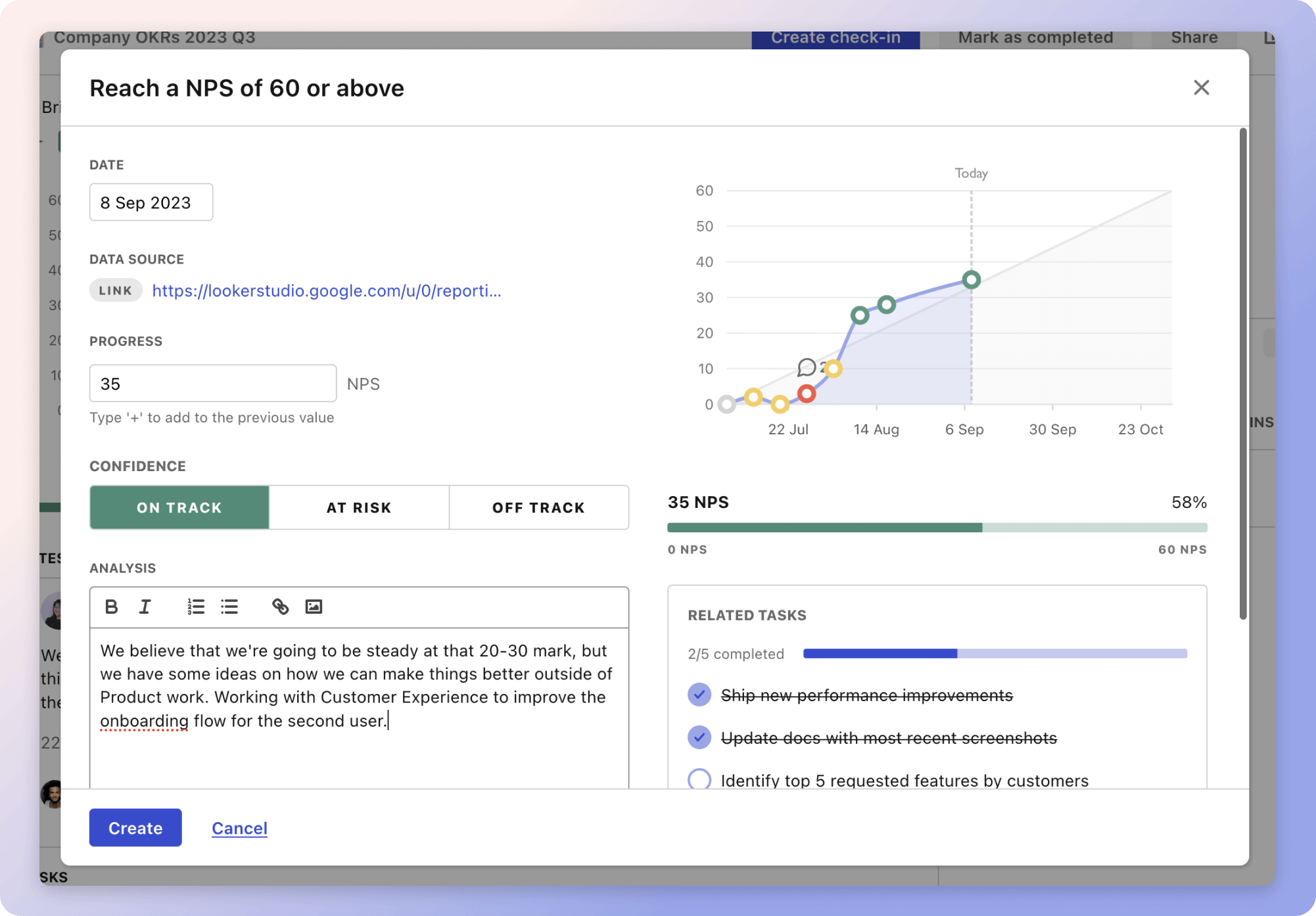2 customisable OKR examples for Corporate Relations Team
What are Corporate Relations Team OKRs?
The Objective and Key Results (OKR) framework is a simple goal-setting methodology that was introduced at Intel by Andy Grove in the 70s. It became popular after John Doerr introduced it to Google in the 90s, and it's now used by teams of all sizes to set and track ambitious goals at scale.
Writing good OKRs can be hard, especially if it's your first time doing it. You'll need to center the focus of your plans around outcomes instead of projects.
We have curated a selection of OKR examples specifically for Corporate Relations Team to assist you. Feel free to explore the templates below for inspiration in setting your own goals.
If you want to learn more about the framework, you can read our OKR guide online.
Building your own Corporate Relations Team OKRs with AI
While we have some examples available, it's likely that you'll have specific scenarios that aren't covered here. You can use our free AI generator below or our more complete goal-setting system to generate your own OKRs.
Feel free to explore our tools:
- Use our free OKR generator
- Use Tability, a complete platform to set and track OKRs and initiatives, including a GPT-4 powered goal generator
Our customisable Corporate Relations Team OKRs examples
You will find in the next section many different Corporate Relations Team Objectives and Key Results. We've included strategic initiatives in our templates to give you a better idea of the different between the key results (how we measure progress), and the initiatives (what we do to achieve the results).
Hope you'll find this helpful!
1. OKRs to successfully raise $2M at an upcoming fundraising event
Successfully raise $2M at an upcoming fundraising event
Obtain corporate sponsorships adding to $750K
Identify potential corporations interested in sponsoring your organization
Craft a dynamic, tailored sponsorship proposal for each corporation
Arrange meetings to pitch sponsorship opportunities and benefits
Secure pledges from 10 major donors contributing $500K collectively
Identify and list potential major donors
Facilitate meetings to discuss pledges
Develop personalized proposals for each donor
Attract 1,000 event attendees at $500 donation per ticket
Leverage partnerships for greater visibility and reach
Develop targeted marketing strategies to reach potential donors
Organize high-value perks and incentives for attendees
2. OKRs to to enhance and maximize business stakeholder engagement
To enhance and maximize business stakeholder engagement
Increase interaction rate on professional social networks by 30%
Increase frequency of timely and relevant posts
Initiate networking events and online discussions
Develop and implement engaging content strategy regularly
Secure 15% increase in returning clients through improved communication strategies
Implement weekly newsletters highlighting service benefits and company updates
Offer personalized follow-ups to assess client satisfaction post-service
Launch engaging client loyalty program with exclusive benefits
Arrange and execute two productive stakeholder meetings monthly
Develop and distribute agenda prior to meetings
Identify key stakeholders to include in monthly meetings
Schedule two monthly meetings accommodating stakeholders' availability
Corporate Relations Team OKR best practices to boost success
Generally speaking, your objectives should be ambitious yet achievable, and your key results should be measurable and time-bound (using the SMART framework can be helpful). It is also recommended to list strategic initiatives under your key results, as it'll help you avoid the common mistake of listing projects in your KRs.
Here are a couple of best practices extracted from our OKR implementation guide 👇
Tip #1: Limit the number of key results
The #1 role of OKRs is to help you and your team focus on what really matters. Business-as-usual activities will still be happening, but you do not need to track your entire roadmap in the OKRs.
We recommend having 3-4 objectives, and 3-4 key results per objective. A platform like Tability can run audits on your data to help you identify the plans that have too many goals.
 Tability's audit dashboard will highlight opportunities to improve OKRs
Tability's audit dashboard will highlight opportunities to improve OKRsTip #2: Commit to weekly OKR check-ins
Don't fall into the set-and-forget trap. It is important to adopt a weekly check-in process to get the full value of your OKRs and make your strategy agile – otherwise this is nothing more than a reporting exercise.
Being able to see trends for your key results will also keep yourself honest.
 Tability's check-ins will save you hours and increase transparency
Tability's check-ins will save you hours and increase transparencyTip #3: No more than 2 yellow statuses in a row
Yes, this is another tip for goal-tracking instead of goal-setting (but you'll get plenty of OKR examples above). But, once you have your goals defined, it will be your ability to keep the right sense of urgency that will make the difference.
As a rule of thumb, it's best to avoid having more than 2 yellow/at risk statuses in a row.
Make a call on the 3rd update. You should be either back on track, or off track. This sounds harsh but it's the best way to signal risks early enough to fix things.
How to turn your Corporate Relations Team OKRs in a strategy map
OKRs without regular progress updates are just KPIs. You'll need to update progress on your OKRs every week to get the full benefits from the framework. Reviewing progress periodically has several advantages:
- It brings the goals back to the top of the mind
- It will highlight poorly set OKRs
- It will surface execution risks
- It improves transparency and accountability
Spreadsheets are enough to get started. Then, once you need to scale you can use a proper OKR platform to make things easier.
 Tability's Strategy Map makes it easy to see all your org's OKRs
Tability's Strategy Map makes it easy to see all your org's OKRsIf you're not yet set on a tool, you can check out the 5 best OKR tracking templates guide to find the best way to monitor progress during the quarter.
More Corporate Relations Team OKR templates
We have more templates to help you draft your team goals and OKRs.
OKRs to enhance lead generation by delivering high-quality content
OKRs to ensure successful completion of Annual Audit Plan
OKRs to improve mobile app reusability throughout the organization
OKRs to successfully launch startup
OKRs to successfully procure and implement a smart workplace management system
OKRs to attain proficiency in React and develop a medium-level application
OKRs resources
Here are a list of resources to help you adopt the Objectives and Key Results framework.
- To learn: What is the meaning of OKRs
- Blog posts: ODT Blog
- Success metrics: KPIs examples
Create more examples in our app
You can use Tability to create OKRs with AI – and keep yourself accountable 👀
Tability is a unique goal-tracking platform built to save hours at work and help teams stay on top of their goals.
 1 Create your workspace
1 Create your workspace 2 Build plans in seconds with AI
2 Build plans in seconds with AI 3Track your progress
3Track your progress